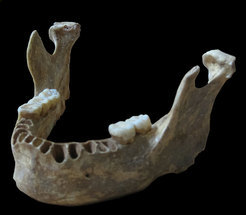Genetic analysis of a 40,000-year-old jawbone from Romania reveals that early modern humans interbred with Neandertals when they first came to Europe
Neandertals became extinct about 40,000 years ago but contributed on average one to three percent to the genomes of present-day Eurasians. Researchers have now analyzed DNA from a 37,000 to 42,000-year-old human mandible from Oase Cave in Romania and have found that six to nine percent of this person’s genome came from Neandertals, more than any other human sequenced to date. Because large segments of this individual’s chromosomes are of Neandertal origin, a Neandertal was among his ancestors as recently as four to six generations back in his family tree. This shows that some of the first modern humans that came to Europe mixed with the local Neandertals.
